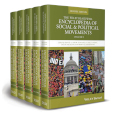Ethnic Studies and Social Movements
Abstract
Ethnic studies departments, including African American studies, Asian American studies, Chicana/o/x studies, and Native American studies, emerged from the social ferment of the late 1960s. Students of color, along with some progressive and radical white students, called for critical, culturally relevant education that would liberate oppressed peoples all over the world. Nineteen-sixty-eight was the “year of the boomerang,” as the “wretched of the earth” (people of color, indigenous people, working-class people, women, queer people, and many others) rose up and demanded their freedom. Naming the enemy – colonialism, imperialism, capitalism, white supremacy, institutional racism, fascism – students of color, particularly black students, organized and participated in “high-risk” actions such as sit-ins, strikes, occupations, and even armed self-defense. While iconic moments such as the 134-day strike at San Francisco State University (SFSU) led by the Black Student Union and Third World Liberation Front (twLF) in 1968–1969 and the Columbia University student strike in 1968 are well known, many other protests occurred that same year. At the University of California, Santa Barbara (UCSB), for example, black students took over a key building that housed all campus computer records in October 1968. Students threatened that unless several key demands were met, including the establishment of a black studies department, the records would be destroyed. Shortly thereafter, the UCSB Black Studies Department was opened, as was the Chicano Studies Department after Chicana/o students mobilized and held a historic conference known as El Plan de Santa Barbara in April 1969. The UCSB Chicano Studies Department was the first such academic unit in the entire UC system.



